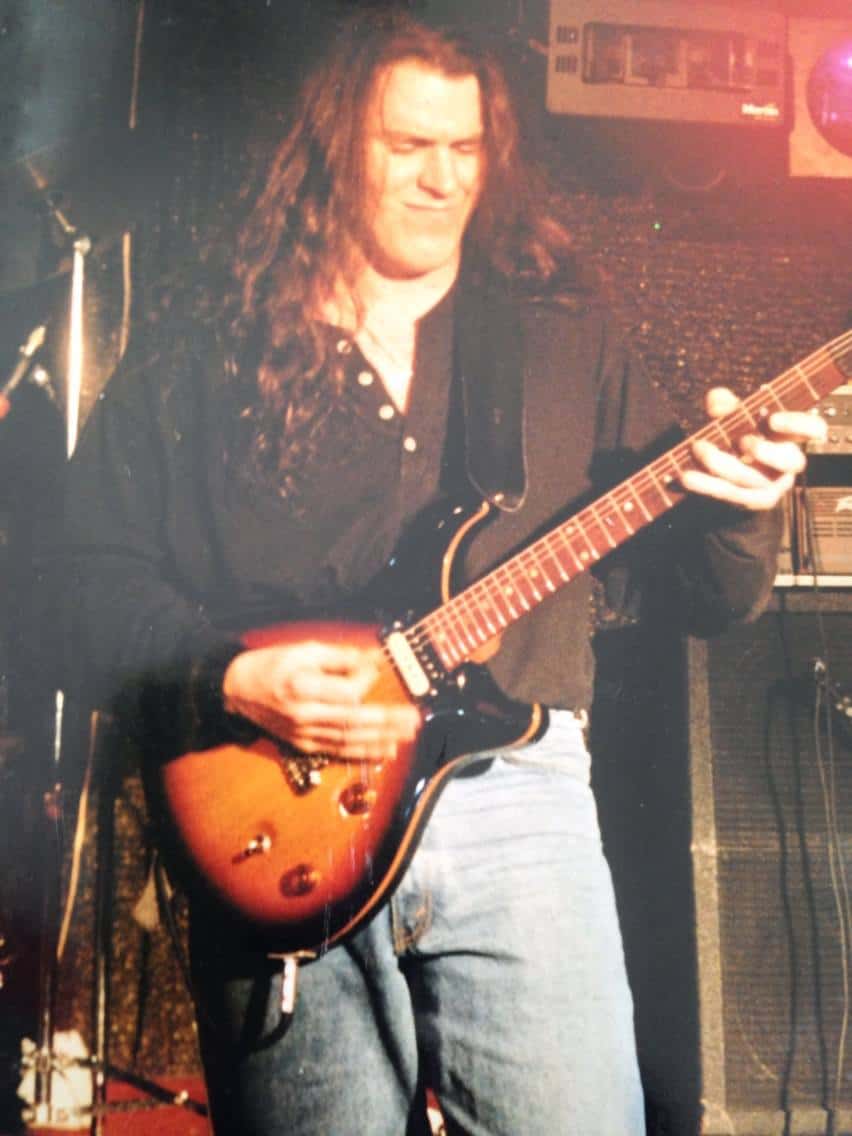How the Guitar Modal Scale Workout Started
Back in the 1990s, I was teaching guitar lessons at Lentine’s Music in Akron, Ohio. I was teaching 6 days a week and playing gigs at night on the weekends. Before the internet, before cell-phones, before YouTube lessons… you had to take lessons in person from an actual person.
I have a lot of great memories from those years. Consequently, at one point I had over 70 students per week and a waiting list of another 20-30 people waiting for cancellation spots. As much as I’d like to think I was good at my job, the truth is; I was learning just as much from my guitar students as they were learning from me.
As a result, I still feel that way today.
The Modal Scale Exercise for Guitarists

This ‘Modal Workout’ started off as a hand written scribble on some music paper that I handed out to advanced students as a challenging exercise.
The ‘workout’ provided the additional benefit of memorizing sequences and shapes in a key. Very useful for building improvisational skills along with a strong technical foundation on guitar.
When I started my website, one of the first things I offered to the wonderful guitarists who joined my email list was this Guitar Modal Workout. A simple 2 page PDF.
No instructions, no explanation, no text; just the same exercise I was handing out to students over 25 years ago.
The funny thing was, people still loved it!
Last week I was doing some website maintenance and noticed something that struck me. The little Modal Workout I started back in the 90s had gotten over 20,000 downloads. (!!!)
I finally got around to organizing it a bit better and with more explanation and thoughts on Guitar Modal Scales in general. I took a few excerpts from my online guitar lessons and included them here as accompaniment to fill things out.
There is much to explore down the modal theory rabbit-hole. I offer only the tip of the iceberg in this little guide. As always, I encourage you to take your own studies deeper and beyond what you can get from any one source.
The Guitar Modal Workout Book
Here’s what you can get in the new Guitar Modal Workout:
- 45 Page, Full Color eBook (PDF works on any device)
- Explanation of the Major Scale.
- Circle of Keys Explained.
- What a mode is and how to build them in any key.
- How modes and chords relate to each other on the guitar fretboard.
- All 7 Mode Shapes (block shapes).
- 3 note-per-string shapes.
- Melodic Minor Mode shapes.
- Harmonic Minor Mode shapes.
- How modes overlap on the guitar neck.
- How to build sequences across modal scales.
- The original Modal Scale Workout.
- The updated 2020 Modal Scale 2.0 Workout.
- TAB and Standard Notation.
- The Modal Workout is now available in paperback!

Practicing modal scales on the guitar
Working on modal scales is a great way to improve your understanding of music theory and expand your improvisation skills. Here are some exercises you can try:
1. Learn the Modes: Start by learning the seven modes of the major scale – Ionian, Dorian, Phrygian, Lydian, Mixolydian, Aeolian, and Locrian. Each mode has a unique sound and characteristic that you can explore.
2. Practice Scale Patterns: Practice playing each mode in different positions on the fretboard using scale patterns. Start with one mode at a time, ensuring you can play it smoothly and accurately before moving on to the next.
3. Scales Sequences: Try playing the modes in different sequences such as thirds, fourths, fifths, or in a zig-zag pattern. This will help you become more fluent in moving between different modes.
4. Modal Interchange: Experiment with modal interchange by switching between modes within a progression. This can help you understand how different modes create unique harmonic colors.
5. Guitar Jam Tracks: Practice playing modal scales over backing tracks or loops in different keys. This will help you improvise and develop your ear for modal sounds.
6. **Use a Metronome**: Practice your modal scales with a metronome to improve your timing and precision. Start slow and gradually increase the tempo as you become more comfortable. Remember to focus on both technique and musicality while practicing modal scales. Consistent practice and experimentation will help you internalize the sounds of each mode and incorporate them into your playing effectively.
Table of Contents for the Modal Workout 2.0 Book
Preface 5
Introduction 6
About This Book 7
Some Thoughts On Technique 7
Alternate Picking 8
What is a Scale? 8
The Circle of Keys 9
How the Circle Works 11
What is a Mode? 13
Some Thoughts on Modes 14
The Key Center Approach 14
Modal Characteristics 15
Mode Formulas and Characteristics 16
Ionian 16
Dorian16
Phrygian 16
Lydian 16
Mixolydian 17
Aeolian 17
Locrian 17
Modes on the Guitar Neck 18
Old-School Block-Style Guitar Mode Shapes 18
A Dorian / A minor Chord 19
B Phyrgian / B minor Chord 20
C Lydian with a C Major chord. 21
D Mixolydian with a D Major chord. 22
E Aeolian, a.k.a., the E Natural Minor scale and chord. 23 F# Locrian and the diminished chord. 24
Block Shapes vs. 3 Note-Per-String Shapes 25
It came from the 80’s…. 26
The Guitar Mode Overlap 27
Some Practice Tips 31
Modal Shapes 32
Sequences 34
Minor Modes 36
The Modal Workout 37
The Modal Workout 2.0 2020 version 40
Authors Note 45

If you’ve read this far, thank you! The great news is, I’m offering it free for my email subscribers. You also get access to the Guitar Printable area with tons of free lessons and music. No catch, unsubscribe at any time.
Don’t want any emails? No problem, I get it. You can grab your full-color book here for only $9.99:
Craig Smith is a professional Guitarist, Teacher, and Writer living in Sanford, Florida. Craig has taught guitar lessons, performed 200+ gigs per year for nearly 30 years, and published 4 guitar instructional books. When he’s not gigging or writing, you may find him by the pool with his wife Celeste, 4 Chihuahuas, and a drink. 🎸

